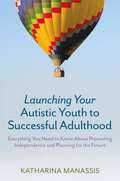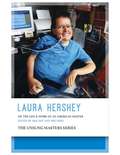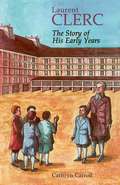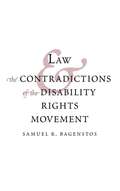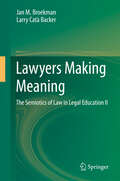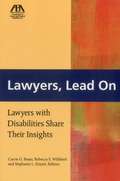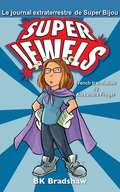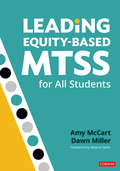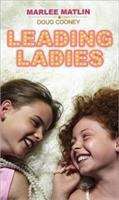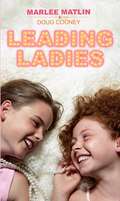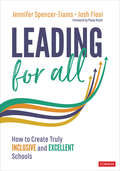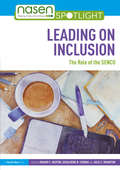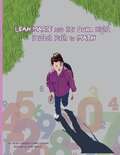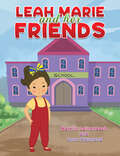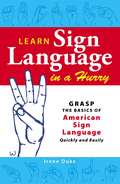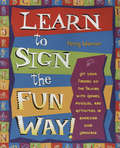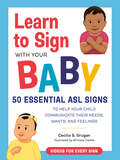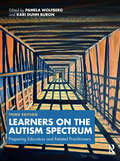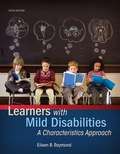- Table View
- List View
Laughter in Darkness
by Robert O'Neil BristowMitchell Ashley, who lost his sight due to iritis four years ago, is determined to be independent and not to be a burden on others. However, his bravado gets him into one scrape after another. Mitchell rewards his guide dog with bowls of beer and entertains a stream of female companions in the bedroom of the apartment which he shares with his friend Hubert. Georgia, his reader and lover, longs for a committed relationship with Mitchell, but it doesn't seem possible.
Launching Your Autistic Youth to Successful Adulthood: Everything You Need to Know About Promoting Independence and Planning for the Future
by Katharina ManassisThe transition from high school to adulthood is one of the most challenging times for young people on the autism spectrum. What will happen when all their familiar teachers, educational assistants and friends disappear after graduation? Who will replace them in the adult world? How will they manage this drastic change? Drawing on her experiences as the mother of a child on the autism spectrum and a child psychiatrist, Katharina Manassis shares common transition-related challenges and offers real solutions for each. The book helps parents and teens plan for every stage of the journey. The book includes discussion of what a successful transition means and how to set realistic goals. It explores specific aspects of the transition such as employment, independence and social life, and looks at how to address long-term concerns such as living arrangements and financial support.
Laura Hershey: On the Life and Work of an American Master (Unsung Masters Series)
by Meg Day Niki HerdLaura Hershey's poetry reflects her commitment to disability activism and her identity as a member of the LGBTQ+ community. This book contains a representative selection of her poems as well as critical essays about her work.
Lauren's World: My Life with Cerebral Palsy
by Lauren TrevarthenTake a trip with Lauren as she navigates through her life with Cerebral Palsy. You'll read how just eating a meal can be both satisfying and frustrating at the same time. Lauren hopes you can better understand what it's like living with a physical disability. You can contact me on my website www.queenlaurentrevarthen.com
Laurent Clerc: The Story of His Early Years
by Cathryn CarrollLaurent Clerc won lasting renown as the deaf teacher who helped Thomas Hopkins Gallaudet establish schools to educate deaf Americans in the 19th century. Now, his character as a young boy growing up in Paris has been captured in the novel Laurent Clerc. In his own voice, Clerc vividly relates the experiences that led to his later progressive teaching methods. Especially influential was his long stay at the Royal National Institute for the Deaf in Paris, where he encountered sharply distinct personalities -- the saintly, inspiring deaf teacher Massieu, the vicious Dr. Itard and his heartless "experiments" on deaf boys, and the "Father of the Deaf," Abbe Sicard, who could hardly sign. Young adult readers will find his story richly entertaining as well as informative.
Law and the Contradictions of the Disability Rights Movement
by Samuel R. BagenstosThe passage of the Americans with Disabilities Act in 1990 was hailed as revolutionary legislation, but in the ensuing years restrictive Supreme Court decisions have prompted accusations that the Court has betrayed the disability rights movement. The ADA can lay claim to notable successes, yet people with disabilities continue to be unemployed at extremely high rates. In this timely book, Samuel R. Bagenstos examines the history of the movement and discusses the various, often-conflicting projects of diverse participants. He argues that while the courts deserve some criticism, some may also be fairly aimed at the choices made by prominent disability rights activists as they crafted and argued for the ADA. The author concludes with an assessment of the limits of antidiscrimination law in integrating and empowering people with disabilities, and he suggests new policy directions to make these goals a reality.
Lawyers Making Meaning....
by Jan M. Broekman Larry Catà BackerThis book present a structure for understanding and exploring the semiotic character of law and law systems. Cultivating a deep understanding for the ways in which lawyers make meaning--the way in which they help make the world and are made, in turn by the world they create --can provide a basis for consciously engaging in the work of the law and in the production of meaning. The book first introduces the reader to the idea of semiotics in general and legal semiotics in particular, as well as to the major actors and shapers of the field, and to the heart of the matter: signs. The second part studies the development of the strains of thinking that together now define semiotics, with attention being paid to the pragmatics, psychology and language of legal semiotics. A third part examines the link between legal theory and semiotics, the practice of law, the critical legal studies movement in the USA, the semiotics of politics and structuralism. The last part of the book ties the different strands of legal semiotics together, and closely looks at semiotics in the lawyer's toolkit--such as: text, name and meaning.
Lawyers, Lead On: Lawyers with Disabilities Share Their Insights
by Rebecca S. Williford Carrie A. Basas Stephanie L. EnyartThis inspiring book contains letters of encouragement and advice from lawyers with disabilities to law students and new lawyers with disabilities. The writers share their perspectives on work and disability, based on their own experiences of success and setbacks.
Le journal extraterrestre de Super Bijou
by Alexandra Froger Bk BradshawPourquoi tout semble si facile pour les autres ? Bijou nous raconte ses aventures de la Maternelle-Prison jusqu'au Collège, tout en cherchant des indices sur ce qui la distingue des autres. Pourrait-elle être une extraterrestre, un super-héro ou quelque chose de complètement différent ? Rejoignez Bijou dans son exploration de ce monde confus - et souvent hilarant - des attentes sociales. Le voyage de Bijou à la découverte de soi, l'emmène à des endroits inattendus et le plus surprenant est de se retrouver un peu nous même en cours de route.
Leading Equity-Based MTSS for All Students
by Amy McCart Dr. Dawn Dee MillerEnsure that Every Child Achieves Academic and Social Success An equity-based multi-tiered system of support (MTSS) helps school teams engage all students across the full range of learning needs. MTSS ensures that the vision of equity for every student is achieved, with high expectations and quality instruction, while not straining a school&’s budget or personnel. This strategy filled book teaches you how to • Engage all students in learning through an equity-based approach • Analyze and utilize your resources • Apply strengths- and evidence-based principles for implementation • Incorporate effective tools to systematize MTSS
Leading Equity-Based MTSS for All Students
by Amy McCart Dr. Dawn Dee MillerEnsure that Every Child Achieves Academic and Social Success An equity-based multi-tiered system of support (MTSS) helps school teams engage all students across the full range of learning needs. MTSS ensures that the vision of equity for every student is achieved, with high expectations and quality instruction, while not straining a school&’s budget or personnel. This strategy filled book teaches you how to • Engage all students in learning through an equity-based approach • Analyze and utilize your resources • Apply strengths- and evidence-based principles for implementation • Incorporate effective tools to systematize MTSS
Leading Ladies
by Marlee Matlin Doug CooneyMegan's fourth-grade class is putting on their own original musical based on the book The Wizard of Oz, and Megan wants to be the star of the show and play Dorothy. Since she's deaf, she will sign the songs for her audition. However, a problem develops when Lizzie, her best friend from camp, transfers from her all-deaf school to Megan's class - and signs the same two songs that Megan was going to do! Luckily, Megan has some other ideas up her sleeve...
Leading Ladies
by Marlee Matlin Doug Cooney"It doesn't make sense to me...in the book, Dorothy is a girl who can hear and talk - and Toto is a little dog. So I'm sorry - but I just don't see a Dorothy who's deaf and talks with her hands and has a great big dog for Toto!" Megan's fourth-grade class is putting on their own original musical based on the book The Wizard of Oz, and Megan wants to be the star of the show and play Dorothy. Since she's deaf, she will sign the songs for her audition. However, a problem develops when Lizzie, her best friend from camp, transfers from her all-deaf school to Megan's class - and signs the same two songs that Megan was going to do! Luckily, Megan has some other ideas up her sleeve... Academy Award-winning actress Marlee Matlin and Doug Cooney follow Deaf Child Crossing and Nobody's Perfect with this winning story that perfectly captures the humor, joys, and frustration of childhood friendships.
Leading for All: How to Create Truly Inclusive and Excellent Schools
by Jennifer Spencer-Iiams Josh FlosiDevelop inclusive and equitable school communities where all learners thrive Research has shown that inclusive education results in better academic outcomes for ALL students, not just those identified with disabilities, by promoting self-efficacy, improving social and emotional health, and consistently implementing research-based instructional strategies. Still, many schools rely on deeply ingrained, segregated practices that fail to serve all students. Leading for All is a practical guide that provides a clear pathway for educators to develop a more inclusive school community from start to finish. Authors Jennifer Spencer-Iiams and Josh Flosi share lessons learned from spending nearly a decade building district schools where all students are served in their neighborhood school and in classrooms with their general education peers. Features include: Three focus areas to guide change: Creating Inclusive Cultures, Improving Instructional Practices, and Increasing Student Voice 7 Components of Inclusive and Equitable Learning Communities Supporting resources for promoting inclusion throughout the school day, including co-curricular activities and transportation Stories of real students and teachers and the actions that impacted their success Educators and school leaders want to create inclusive and excellent educational experiences for all students, but they do not always know how to proceed. Leading for All provides a model, stories, strategies, and clear evidence that it can be done effectively.
Leading for All: How to Create Truly Inclusive and Excellent Schools
by Jennifer Spencer-Iiams Josh FlosiDevelop inclusive and equitable school communities where all learners thrive Research has shown that inclusive education results in better academic outcomes for ALL students, not just those identified with disabilities, by promoting self-efficacy, improving social and emotional health, and consistently implementing research-based instructional strategies. Still, many schools rely on deeply ingrained, segregated practices that fail to serve all students. Leading for All is a practical guide that provides a clear pathway for educators to develop a more inclusive school community from start to finish. Authors Jennifer Spencer-Iiams and Josh Flosi share lessons learned from spending nearly a decade building district schools where all students are served in their neighborhood school and in classrooms with their general education peers. Features include: Three focus areas to guide change: Creating Inclusive Cultures, Improving Instructional Practices, and Increasing Student Voice 7 Components of Inclusive and Equitable Learning Communities Supporting resources for promoting inclusion throughout the school day, including co-curricular activities and transportation Stories of real students and teachers and the actions that impacted their success Educators and school leaders want to create inclusive and excellent educational experiences for all students, but they do not always know how to proceed. Leading for All provides a model, stories, strategies, and clear evidence that it can be done effectively.
Leading on Inclusion: The Role of the SENCO (nasen spotlight)
by Mhairi C. Beaton; Geraldene N. Codina; Julie C. WhartonThis comprehensive resource provides a range of perspectives on inclusion, giving Special Educational Needs Co-ordinators (SENCOs) the opportunity to consider the principles and practice that underpin their leadership role. Offering a blend of academic and professional knowledge, each chapter explores different aspects of the role of the SENCO and supports areas that will be considered as part of the National Award for SENCOs. A variety of essential topics are covered, from the importance of SEND provision and multi-disciplinary practice, to the role of the SENCO and leadership. Key features of this book include: Contributions by leaders of the National Award for Special Educational Needs Co-ordinators working with trainee SENCOs across the country A focus on encouraging SENCOs to think deeply about their own individual practice through engagement with cutting-edge research A flexible structure that can be read as a whole, or dipped in and out of as professional learning needs require This book provides an opportunity for readers to engage with a multiplicity of voices and approaches, allowing them to critically explore their role as leaders of SEND provision in schools. It is an invaluable resource both for students and those already within the role of Special Educational Needs Co-ordinator.
Leading the Way: The Story of Leader Dogs for the Blind
by William D. EisenbergFrom the Book jacket: In this book, William D. Eisenberg has retained the salient features of his first work, He Leadeth Me, The Leader Dog Story (published in 1982) yet expanded his discussion to show Leader Dog's growth and impact, domestically and worldwide, particularly in the last twenty years. Through the insight and experiences of Leader Dog's contemporary pioneers-staff members, graduates, Field Representatives and volunteers-Eisenberg shows how and why Leader Dogs for the Blind has become such a progressive dog guide school and will continue Leading the Way well into the 21st Century.
Leah Marie and Her Down Right Perfect Path to Math
by Marylin Leinenbach Anne RaymondThis is a story of a little girl, Leah Marie, who has Down syndrome. As she spends a week with her Gram, she shares with the reader fun ways that she and her Gram recognize and write numbers during the week. Leah Marie also takes the reader on an exciting journey as she shares mathematical shapes that she sees in her world. Leah Marie's message to all the readers is that math can be fun for everyone.
Leah Marie and Her Friends
by Marylin LeinenbachIn the times we are living in, we all need to be more aware that we should not be focusing on differences, but rather on how we are alike. All children want to have friends, especially in school. However, some children may worry that they will not be understood in their attempt towards friendship, as they have difficulty communicating.In this story, Leah Marie, a little girl with Down syndrome who cannot speak clearly, wonders how she will make friends in school. The dilemma is solved when her school celebrates World Down Syndrome Day to help the children better understand how Leah communicates and how they can help her learn.The moments shared in this book come directly from the experiences of Leah Marie, the great-granddaughter of one of the authors. This book is relatable to all families, caretakers and teachers who struggle to help children realize the many ways they can express their thoughts and feelings.There is a positive message at the end about creative and unique ways to communicate with others. This is a must-read for a wide audience of those who live with and interact with children of all ages and abilities every day.
Learn Sign Language in a Hurry
by Irene Duke"I love you." "What can I get you?" "Let's take a walk."Wanting to say simple things like these but not being able to is frustrating and disheartening--but learning how to communicate can be easy and fun! This book is a basic guide to the alphabet, vocabulary, and techniques it takes to connect using American Sign Language. Whether signing out of necessity or learning for the sake of growing, you will enjoy this practical primer. After reading this book, you will be able to use American Sign Language in a social, educational, or professional setting. Whether the goal is to communicate with hearing-impaired grandparent, a child with special needs in school, or an infant, people learn sign language for many different reasons. Easy to read and reference--and complete with images and examples of common signs --this basic guide allows you to make a meaningful connection that's otherwise impossible.
Learn Sign Language in a Hurry: Grasp the Basics of American Sign Language Quickly and Easily
by Irene Duke"I love you.""What can I get you?""Let's take a walk."Wanting to say simple things like these but not being able to is frustrating and disheartening-but learning how to communicate can be easy and fun! This book is a basic guide to the alphabet, vocabulary, and techniques it takes to connect using American Sign Language. Whether signing out of necessity or learning for the sake of growing, you will enjoy this practical primer. After reading this book, you will be able to use American Sign Language in a social, educational, or professional setting.Whether the goal is to communicate with hearing-impaired grandparent, a child with special needs in school, or an infant, people learn sign language for many different reasons. Easy to read and reference-and complete with images and examples of common signs-this basic guide allows you to make a meaningful connection that's otherwise impossible.
Learn to Sign the Fun Way! Let Your Fingers Do the Talking with Games, Puzzles, and Activities in American Sign Language
by Penny WarnerThe perfect guide to signing for everyone! Never before has learning to sign been so simple and so much fun! Whether you are a teacher or a parent, this lively self-guided book of American Sign Language (ASL) will quickly become your kids' new favorite teacher! Learn to Sign the Fun Waygoes beyond the manual alphabet and teaches the beautiful language of sign—the United States' fourth most pervasive language—in a simple, interactive format. Signers-to-be will discover: ·Great games to make learning ASL an entertaining adventure ·Activities for both the individual and the classroom ·Cool groups of signs that appeal esspecially to kids ·And much more! Kids love to sign, whether it be to communicate with a hearing-impaired individual or as a "secret" language with their friends. With this illustrated book they'll quickly and easily become signing superstars! Inside are cool signs for kids, including: ·People signs ·Alphabet and numbers ·Animals ·Food and drinks ·Home signs ·Clothing ·Color ·Sports ·Activity signs ·Thoughts and feelings ·Action signs ·Body parts ·School talk ·Calendar signs ·Silly and fun signs
Learn to Sign with Your Baby: 50 Essential ASL Signs to Help Your Child Communicate Their Needs, Wants, and Fe elings
by Cecilia S. GruganCommunicate, connect, and bond with your baby with 50 essential, easy-to-learn ASL signs.Your baby is crying. Are they hungry or are they tired? With 50 practical ASL signs that cover a child&’s day, Learn to Sign with Your Baby will help you better understand your child and help them communicate with you. Author Cecilia S. Grugan, a Deaf parent, gives you detailed instructions and tips for how to master each sign, as well as helpful advice and fun activities for incorporating ASL into your life with baby. And with clear illustrations and video demonstrations for each sign, you can confidently start signing with your baby—and watch as your bond deepens and strengthens.Learn to Sign with Your Baby includes: 50 of the most useful ASL signs. From &“more&” and &“eat&” to &“change&” and &“hurt,&” this book teaches the most relevant and practical terms for your daily life with baby—and makes signs for specific needs easy to find.Step-by-step color illustrations and video for every sign. The video for each sign can be accessed by a QR code; scan it for step-by-step guidance to confidently and correctly form each sign.Engaging activities make ASL fun. Play a game, sing a song—this book makes incorporating ASL into your life enjoyable and rewarding.Helpful tips. Tips for remembering the signs, how to effectively use them, and what to look for as baby signs back make ASL easy to learn and easy to use.
Learners on the Autism Spectrum: Preparing Educators and Related Practitioners
by Pamela Wolfberg Kari Dunn BuronThis third edition is a foundational text that has been updated and expanded to prepare educators, therapists, and other care providers with vital knowledge and practical skills to support diverse learners on the autism spectrum. Covering an expanse of fundamental topics, this edited volume features new directions in research and practice that are essential to understanding the ever-changing field of autism. Along with new chapters from leading experts (including those who identify as autistic), this revision places greater emphasis on the intersection of neurodevelopmental differences with ethnicity, race, culture, language, gender expression, and socioeconomic experiences. The diverse disciplines and perspectives presented provide a foundation on how these students learn and how best to provide them with effective teaching, therapy, and social supports. This book equips readers with knowledge and skill to competently apply reflective and humanistic practices that prioritize the preferences, strengths, and values of autistic learners from all walks of life.
Learners with Mild Disabilities: A Characteristics Approach
by Eileen B. RaymondLearners with Mild Disabilities: A Characteristics Approach focuses on high-prevalence disorders affecting school learners today, including mild intellectual disabilities, learning disabilities, emotional/behavioral disorders, ADHD, autism spectrum disorders, and communication disorders, as well as on low incidence conditions that may manifest in the milder range, for example sensory, physical, health, or TBI. The author lays the foundation for addressing the needs of special learners and then focuses on learners from the perspective of alternative non-categorical frameworks. She describes students with disabilities and related conditions with respect to a variety of individual strengths and needs, considering their cognitive, language, academic learning, and social/emotional characteristics. Readers see how to apply these conceptual frameworks by analyzing a number of vignettes and extended case studies based on the experiences of real children and teachers. Designed as a primary text for use in undergraduate and graduate courses addressing the characteristics of learners with high prevalence or milder levels of disability, the text is also useful for the first specialized course in a special education program. It supports programs in inclusive education or the growing area of generic special education. The Enhanced Pearson eText features embedded video.

